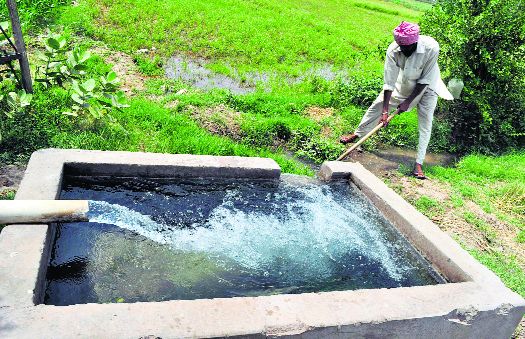
The depletion of the water table in Punjab started back in the 1970s.
Vishav Bharti
Punjab is extracting water from the ground at the highest speed in the country. If the practice goes on unabated, the state will be rendered a desert in the next two decades. Numerous studies in the past three decades have warned of such a disaster, but it seems nothing has roused successive governments to take decisive action. The Comptroller and Auditor General’s (CAG) report on Punjab’s groundwater is the latest addition to a series of damning reports on the subject.
Groundwater extraction has increased from 149 per cent of the total recharge in 2013 to 165 per cent in 2018. Just 60 per cent of Punjab’s groundwater is fit for use and around 85 per cent of the area falls in the overexploited or critical category. A report, ‘Groundwater Resources of Punjab’, prepared by the Central Groundwater Board and the state’s Water Resources & Environment Directorate, found that of the 138 blocks assessed, 109 (79 per cent) were overexploited; 3 per cent critical; 2 per cent semi-critical. Just 16 per cent were in the safe category. In 1989, just 52 per cent of the blocks were categorised as overexploited.
The depletion of the water table is not a new phenomenon. It started in the 1970s with the cultivation of paddy in the state. It was the time when the state started shifting to tubewell irrigation from canal irrigation. Now, 71 per cent of the net irrigated area is under tubewell irrigation, using groundwater, and in only 29 per cent canal water is being used.
As per the report, between June 1984 and June 2016, 37 per cent of the area in Punjab witnessed a fall of up to 10 metres in the groundwater table. During this period, groundwater in 48 per cent of the area fell by more than 10 metres. In the remaining about 15 per cent of the area, the groundwater level had risen. The report has noted that the continuous practice of monoculture of sowing paddy, along with free power for extracting groundwater to irrigate paddy fields, leads to a decrease in groundwater availability in the state.
The CAG has noted that paddy sowing is the main culprit. As per CAG, 97 per cent of the extracted groundwater was being used for irrigation purposes and the rest for domestic and industrial use.
With a view to regulate and control the extraction and management of groundwater, the Centre, from time to time, came up with a Model Bill. But the CAG observed that no effort was made by the state to enact an Act to control the use of groundwater.
The CAG noted that Punjab has the maximum percentage of wells showing depletion in groundwater among the top 10 worst-affected states in the pre-monsoon water level data 2018 when compared with the decadal average (2008-2017). Punjab tops the chart with 84 per cent of the wells showing depletion.
Water-guzzling paddy
The CAG report found that despite enactment of The Punjab Preservation of Sub Soil Water Act, 2009, to prohibit sowing nursery of paddy and transplantation paddy before notified dates, agriculture continued to be dominated by paddy (a water-intensive crop) and wheat monoculture in Punjab, leading to overexploitation of water resources. In addition to the surface water fed through the canal system, there was an increasing pressure on the groundwater resources which are being overexploited to meet needs of intensive irrigation.
Figure it out
- During 2012-16, the net annual groundwater recharge decreased by8 per cent as compared to 2008-12
- Groundwater extraction increased by 3 per cent in the same period
- The number of electricity-operated tubewells increased by 84 per cent from 7.5 lakh in 1996-97 to 13.36 lakh in 2017-18
- Subsidy to meet the expense forproviding free power to agriculture in 2017-18 was Rs 6,578 crore — 94 per cent of total subsidies and 11 per cent of state’s total revenue expenditure
- 10 per cent of the groundwater was unsafe for any purpose and 30 per cent was marginally to moderately saline/alkaline
Join Whatsapp Channel of The Tribune for latest updates.



























